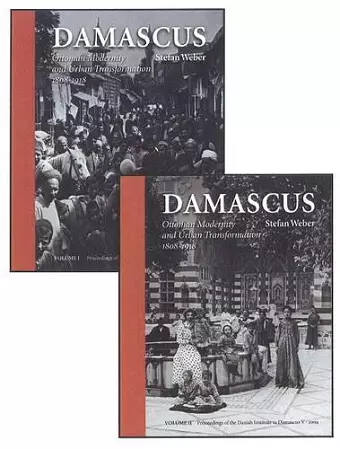Damascus
Ottoman Modernity and Urban Transformation (1808-1918), Vol. 1 & 2
Format:Hardback
Publisher:Aarhus University Press
Published:27th Jan '10
Currently unavailable, our supplier has not provided us a restock date

Damascus, capital of the Ottoman province in Syria and one of the most important centres of the classical Muslim World, underwent some of the same developments in the 19th century as other urban centres in the Mediterranean area and beyond. In the course of the industrial revolution in Europe and the radical expansion of a worldwide network of traffic and communication, new ideas, techniques, material goods and architectural forms spread and challenged locally established patterns of urban and social organisation. This expansion and integration led to an increase in orientation of urban and social structures towards supra-regional models seen, for example, in architecture of houses, public buildings and bazaars or urban organization and clothing. Yet Damascus never became a "European city", but modernised in its own, unique ways. This study examines the society, architecture and urban planning, including the documentation of over one thousand buildings and public spaces, of the endangered UNESCO World Heritage Site of Damascus. The history of these buildings and their transformation are discussed, and many unpublished historical photographs provide an insight into lost and unknown private worlds and urban textures. From a micro-historical approach, this book unfolds the spaces of the everyday life of local actors and agents to unearth and relate the complexity and nonlinear quality of the processes, which transpired as an integral turning point in the history of the Middle East with its entry into modernity.
"Stefan Weber is to be complemented for producing such an outstanding and profoundly impressive work which sets a standard in the field. Damascus: Ottoman Modernity and Urban Transformation, 1808-1918 will be hard to supersede. The Danish Institute in Damascus is also to be commended for including this book in its proceedings." Abdul-Karim Rafeq William and Annie Bickers Professor of Arab Middle Eastern Studies,Emeritus, The College of William and Mary in Virginia (Book Reviews / Turkish Historical Review 4 (2013) 225240) "The books lavish illustrationsover 1,300, not counting local street plansdeserve particular admiration. Virtually every point Weber makes is supported by at least one and sometimes several pictorial examples, drawn from an array of sources among which Webers own photos, the privatecollection of Wolf-Dieter Lemke, and the public collection of the Library of Congress are only the most notable. Copious and detailed primary and secondary source references in the footnotes support the argument throughout and offer numerous avenues for further reading. The book isbeautifully produced: the designer and indexer are rightly credited by name." "...this book is a magnificent monument to the built heritage of Damascus and the lives of countless Damascenes. Photos of crumbling walls and decaying interiors, and many a comment in the text(especially in the catalog), make clear that that heritage was under threat when the research was carried out, between the late 1990s and late 2000s.It is under much greater threat now." - Benjamin Thomas White, Arab Studies Journal
ISBN: 9788779344242
Dimensions: 277mm x 240mm x 100mm
Weight: 5373g
1200 pages